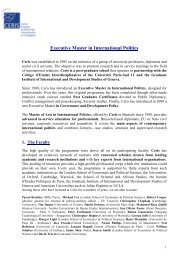hydropolitics of the tigris - euphrates river basin with - ceris.be
hydropolitics of the tigris - euphrates river basin with - ceris.be
hydropolitics of the tigris - euphrates river basin with - ceris.be
You also want an ePaper? Increase the reach of your titles
YUMPU automatically turns print PDFs into web optimized ePapers that Google loves.
<strong>the</strong> Ottoman Empire did <strong>the</strong> Tigris and <strong>the</strong> Euphrates <strong>be</strong>come international <strong>river</strong>s. This paralleled <strong>the</strong> new<br />
independence <strong>of</strong> ex-colonies such as Syria, Iraq and <strong>the</strong> resulting establishment <strong>of</strong> Turkey as a nation-state.<br />
To manage such a large <strong>river</strong> <strong>basin</strong> complex would soon <strong>be</strong>come difficult enough <strong>with</strong> additional players,<br />
<strong>the</strong> new boundaries and a larger management. However <strong>the</strong>se issues would <strong>be</strong>come fur<strong>the</strong>r complicated by<br />
<strong>the</strong> different needs and <strong>the</strong> very different identities <strong>of</strong> each <strong>of</strong> <strong>the</strong>se 3 stakeholders.<br />
Water Development, History and Security in Turkey<br />
“Long-term observers <strong>of</strong> Turkish foreign policy and its major concerns did not identify water as a major<br />
policy concern until <strong>the</strong> last two decades. In contrast to Syria and Iraq, its neighbours to <strong>the</strong> south, Turkey<br />
had not used its water resources extensively.” 14 It can <strong>be</strong> said that in recent years water itself has not <strong>be</strong>come<br />
a foreign policy issue for Turkey but certain issues have <strong>be</strong>come linked to Turkey’s utilisation <strong>of</strong><br />
transboundary waters. As <strong>the</strong> Turkish economy grew, <strong>be</strong>came more industrial and integrated into <strong>the</strong> world<br />
economy, its use and degree <strong>of</strong> water consumption changed markedly.<br />
Unlike Syria and Iraq, who both have a long history <strong>of</strong> irrigation, Turkey’s agriculture tended to <strong>be</strong> dry<br />
(relying largely on natural precipitation) ra<strong>the</strong>r than irrigated. Physically, whatever irrigable land that was<br />
available existed near <strong>river</strong>s whose flow was completely inside <strong>the</strong> country’s boundaries. Consequently <strong>the</strong><br />
majority <strong>of</strong> water consumption in Turkey had little or no transboundary impact <strong>with</strong> its neighbours. Also in<br />
“pre-industrial” Turkey <strong>the</strong> use <strong>of</strong> water resources for hydro-electricity was limited mainly to servicing <strong>the</strong><br />
needs <strong>of</strong> urban centres. The remainder <strong>of</strong> required power supply was provided by imported fossil fuels.<br />
The biggest change in Turkey’s economic history came in <strong>the</strong> 1950’s, just after World War II, when Turkey<br />
joined <strong>the</strong> Western Bloc. This was encouraged and rewarded by financial assistance from <strong>the</strong> United States<br />
and International agencies, who launched a process for economic development. The decision by Turkey to<br />
build itself into an economic player on an international scale was not just due to opportunism but had its<br />
roots earlier in <strong>the</strong> 20 th Century. During <strong>the</strong> 1930’s Turkey had established an independent agency known as<br />
<strong>the</strong> Electrical Resources and Survey and Development Agency who would <strong>be</strong>gin surveying <strong>river</strong>s to<br />
establish <strong>the</strong>ir suitability for hydro-electric production. The agency <strong>be</strong>gan <strong>with</strong> a survey station on <strong>the</strong><br />
Euphrates and by <strong>the</strong> early 1960’s had established a nation-wide network. The administrative and<br />
infrastructural follow-up <strong>of</strong> this network was <strong>the</strong> creation <strong>of</strong> <strong>the</strong> General Directorate <strong>of</strong> State Hydraulic<br />
10





